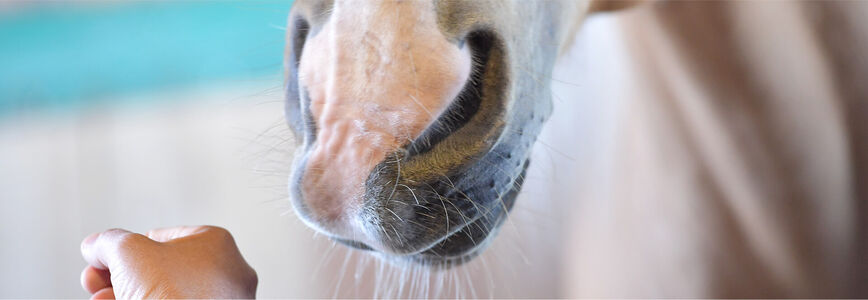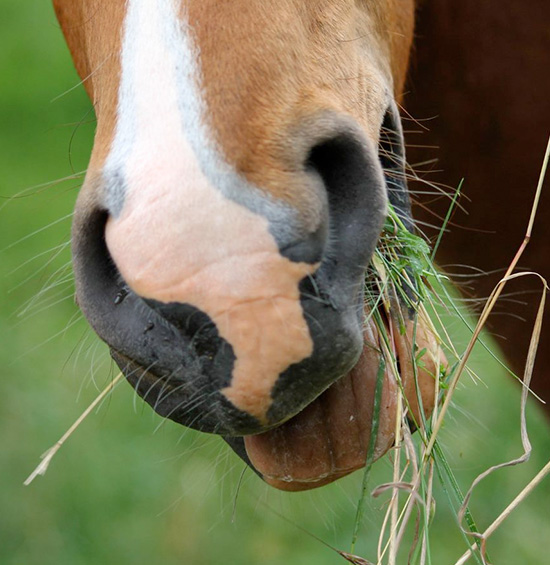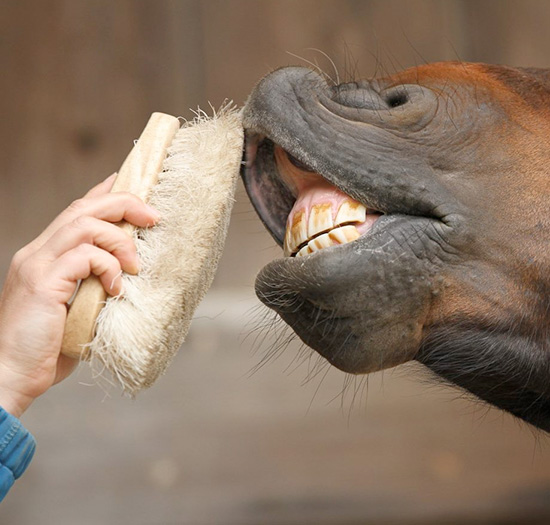
The mouth is used by horses to feel surfaces or to send signals to their outside world. Learn more here.

Due to the many small tactile hairs on the mouth, horses can explore all surfaces with their mouths.
A horse's mouth is very sensitive and is also one of the horses' important means of communication. Equipped with many tactile hairs, foreign objects can be sorted out of the feed and different surfaces can be explored, which is why the hairs must never be shaved or cut. But the lips and mouth are also used to convey signals to the outside world:
The clearest gesture here is the baring of the teeth, which in plain language means: "Get out or I'll bite!". This warning should be taken seriously, because a horse's jaw and its large teeth contain immense power.
The so-called "flehmen" has a purely practical use. When an animal bats, it raises its head and pulls its upper lip upwards to better perceive an unknown or intense smell. Stallions, for example, flehmen when a rosy mare crosses their path, but mares also show this behaviour when they smell something special. In circensics, flehmen is often trained as a trick, as it makes the horses look as if they are grinning.
Chewing is also good for more than just crunching food in different situations. When riding, chewing and the accompanying production of saliva is a sign of looseness and contentment. However, excessive salivation is counterproductive because it triggers a strong swallowing reflex and the animals cannot swallow and breathe at the same time. Therefore, if the working phase is strenuous and intense, care should be taken not to overtax the horse and to give it a break if too much saliva is produced. If a horse chews with its mouth closed without eating anything, this is a sign of concentration and information processing. If a horse catches this during ground work, for example, you can assume that it is actively learning and trying to remember something.
If animals chew with their mouths open while surrounded by conspecifics, this is a gesture of submission. It is especially shown by foals and young animals towards higher-ranking conspecifics and means something like: "I am harmless and will not hurt you!"

Horses require different snaffles depending on the bit. Therefore, it is important to pay attention to the anatomical differences in the mouth of the noble four-legged friend. In general, it is better and more relaxed - also to avoid bruising and to avoid pressure - if the snaffle has about half a centimetre of clearance on each side. Anatomical curb bits generally lie more calmly in the horse's mouth, whereas with normal bits the rider may have to work harder to elicit a desired reaction. It is the same with the thickness. Ideally, this is decided by the horse itself and only in the second instance by the rider. Furthermore, there is the question of whether a single or double bit is better. The rider has to decide individually: a double bit is better for the tongue when the reins are pulled strongly, but it can also impair the blood circulation. A single bit offers more room for manoeuvre and does not squeeze the tongue as quickly.
You also have a lot of leeway when choosing the material. Copper, aluminium, plastic, stainless steel and argentan are just a few to choose from. Some horse owners even do without them altogether.